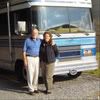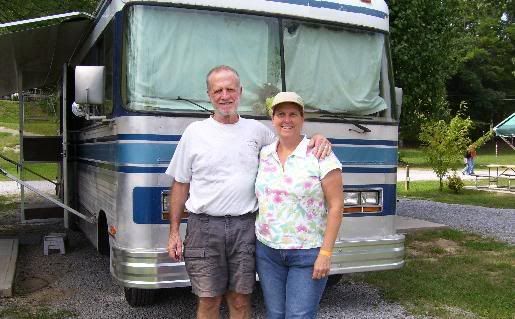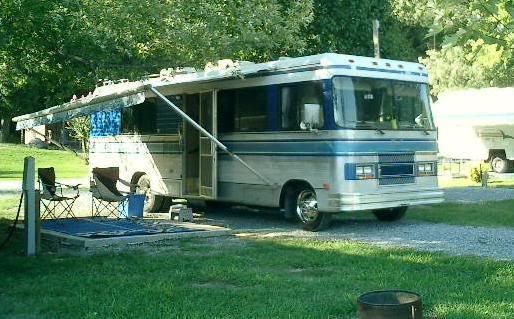Go to...  | Start A New Topic  | Search  | Notify  | Tools  | Reply To This Topic  |  |
 8/19 8/19 |
I was already told I was CRAZY in this post. Water tanks for the most part do not leak. There were two fresh water in my Regency. The tank was leaking because the workers at the Barth factory had squeezed the strap on the outside of the tank to tight. The straps kinked the corner and cracked the tank after time bouncing down the highway. Just like any other project Nick has ever done it turned out to be a case of "Might As Well" fix this too. I replaced the tanks with smaller tanks. I used 40 gallon instead of 45 gallon. My 40 gallon tanks hold the same or more than the 45 gallon tanks. I can utilize all the water in the tanks since the tanks empty fully and fill fully. In the old tanks there always remained water in the bottom of the tank. Dip tubes to the bottom of the tanks drain the tank to the bottom. Air dip tubes to the top of the tank permit the tank to be fully filled with water. I extended some wasted space for my reverse osmosis water system. The space was just empty with no access. Here is the link to the slide show. to the slide show. I will answer any questions you members have about this project. | ||
|
 3/23 3/23 |
Looks like if you waited a year or two you could have taken them out the bottom. | |||
|
 8/19 8/19 |
This is true once the tanks got ran over and mashed like a pancake. It did not look bad from the bottom. The holes were covered by the tank support rails. Rust between the rails hid the holes. The new tanks are supported with bolt on bed frame angle iron rails. The new rail supports are lighter and stronger. Being bolted on and removable so when the tanks are not full I can undercoat the bottom every few years. This should eliminate the rust between the supports and the floor of the basement where the tanks reside. | |||
|
 2/10 2/10 |
Kevin--- very impressive! I hope to NEVER have to consider such a project---- but would definitely look back at your post for inspiration if it happened. Good post! Bud 1993 Breakaway 36ft & 1977 20 ft Spartan: air ride and brakes & P32(?) Cummins: 8.3 litre 250hp, PACBrake Allison 3060 (6 spd) Front entry, side hallway 7.5 kw diesel gen. 1999 2dr Tracker 4X4 5spd, SMI Braking system | |||
|
"Host" of Barthmobile.com 1/19 1/19 |
Wow, the scope of that project. Masterfully done Kevin and well documented.
| |||||||||||||||
| ||||||||||||||||
 8/19 8/19 |
Thanks for the compliments. I can do better. | |||
|
I'll be doing this in the spring. One side at a time. 1993 34 Regency WB 8.3 Cummins 300HP | ||||
|
 6/12 6/12Formally known as "Humbojb"  |
Very impressive. What do you do in your spare time?
| ||||||||||||
|
 8/19 8/19 |
Take the Barth camping. | |||
|
Awesome Kevin! Love all you Barth Masters with confidence, knowledge, skills, and tools. You guys are the Cats Meow! Wally | ||||
|
Official Barth Junkie |
Excellent job. Another major project documented on Barthmobile.com! Now people will know what a Cleco clamp is and how they are used. Bravo Kevin 9708-M0037-37MM-01 "98" Monarch 37 Spartan MM, 6 spd Allison Cummins 8.3 325+ hp | |||
|
 8/19 8/19 |
Here is a narration for my work on the fresh water tanks removal and replacement. posted here. Picture #1. First the rivets all get drilled out. There is a row of rivets under the plastic molding in the aluminum trim. The aluminum trim strip comes off after the rivets are removed. Once all the rivets are removed, I thought the aluminum skin would just pull off. The skin is also glued to the frame rails. It took several hours of carefully pulling and cutting the glue away from the frame rails with a sharp utility knife. So as you can see the first and picture is about two days work. Picture #2. and #3. Looking at the inside of the skin you can see the glue that was cut to separate the skin off of the Barth frame rails. The glue then has to be carefully removed from the back of the skin before the skin is put back on. Picture #4. and #5. With the aluminum skin off the insulation can be removed from between the frame rails. I was surprised to find the fresh water tank was insulated. Picture #6. The insulation on the sides is in good condition. Picture #7. and #8. I had to cut one of the welds on the frame basement supports. This gave me enough room to slide out the plywood. Picture #9. With just one frame basement support removed and a pry bar to bend the plywood, the plywood slid out the back. Picture #10. With the plywood removed you now have access to the Fresh Water Tanks. Picture #11. Before removing the Fresh Water Tanks all the plumbing had to be disconnected. I took plenty of pictures to do the reconstruction of the plumbing and the wiring for the tank level indicators. Picture #12. Everything boxed up for later when new tanks are installed. Picture #13. The easy part about three days into the project. Sliding out the Fresh Water Tank. Picture #14. This part is simple, and the Fresh Water Tank is OUT! Picture #15. Shows the stress crack in the second tank. The line of no paint is where I cut the steel banding strap away. The pressure of the strap caused the tank to bend and fatigue the plastic, while bouncing down the highway. This caused the crack in the tank. Picture #16. This is the insulation and plywood that was rotted and soaked for several years. Maybe 20 years from the cracked tank. The previous owner had the cracked tank plumbed out of the system. It was not used at all. The wet floor came from leaks in the plumbing over the years. The tanks may have been over filled a few times and ran out the top air vent. The floor never had a chance to dry out for 20 years. Picture #17. The rust scale was nearly 1/2 inch thick in some places under the wet insulation and plywood. Picture #18. The rust scale removed to reveal holes. Bad sections were removed completely and replaced. Picture #19. Rusted out Basement frame supports. I had new supports made. Picture #20. More scraping and grinding reveals more holes. Picture #21. More grinding and scraping, and several days to actually dry out the metal. The dark brown is still wet metal. Picture #22. View from the opposite end show more moisture still in the rusty metal. Picture #23. This metal was cut out and replaced. Picture #24. This section also was cut out and replaced. Picture #25. A custom fitted new floor without the look of Swiss Cheese. Picture #26. Some new steel. More than I like to pay, but it was readily available locally. Picture #27. Custom fitted pieces need welded in. Picture #28. New steel welds to old steel. Just learning to overhead weld. Picture #29. View from the bottom. I decided to cut a larger section than shown in picture #23. It was just too rusty to weld to. Picture #30. This is a view of the heater core warmed from the (caterpillar 3208) engine to heat the water compartment while traveling in cold weather. Notice the heating duct has compromised air flow from the factory. I will fix the air duct too. Picture #31. This is the top view of picture #29. Picture #32. This cabinet is being extended past the spring support to match the driver side. It still gives 3" clearance to the drive wheels. Picture #33. Custom fabricated extended cabinet. Lots of angles here to cut and weld. Picture #34. A closer view. You can see the circular welded in bolt supports on the floor. Looks like just piles of weld. They are welded in bolt supports hold up the bed frame rails I used of lighter stronger angle iron. The supports will hold up the 667 pounds of water when the 2 forty gallon fresh water tanks are full. Picture #35. This was more wasted space. I extended this end of the cabinet to make room for a Reverse Osmosis Water Purifying System. The RO System will purify water while on the highway. It can purify fresh water in one tank and dump brine water into the other tank. I can still use the brine water to shower and wash dishes, brush teeth and etc. The foam on top is where I insulated the propane lines to the furnace and the stove. They will remain on the outside of the cabinet. If a leak occurs the propane will not fill any basement storage areas. Picuture #36. Here is shown custom cabinet extension material needed in picture in #35. Picture #37. Notice the custom top this cabinet area is sloped. Sloping will direct any propane leak to the ground outside the Barth. Keeping the fresh water cabinet from filling up with the propane or entering the living area inside. Picture #38. Custom fitting the steel for an air tight fit. Picture #39. Perfect for the Reverse Osmosis System. Picture #40. Notice the weld circle again that will support the tank support rails at this end. Picture #41. Everything is coated with Phosphoric Acid prior to painting with undercoating rust sealer. Picture #42. Phosphoric Acid seals the metal from rust. Picture #43. With the fresh water tanks in place I can now weld the new frame supports back place. Picture #44. The skin is adjusted into place with Cleco Fasteners. Before the skin was installed, I placed Gorilla tape on the steel rails to separate the steel from the aluminum skin. Plain duct tape was used on the original Barth build and after 25 years was still doing the job needed. Since the duct tape was still in place so long, I used the gorilla tape to get the same results. Picture # 45. You can see more Cleco Fastening work. Also notice the white Vent and Fill cap on the upper left of the photo. My tanks can be filled with a hose just hung in the white Vent and Fill Inlet. I can also fill from the standard hose hook up on the driver side with the auto shut off. Picture #46. Shows the 1 1/4 in line I used for the gravity fill to accommodate a fast fill. Picture #47. It does take time and patience to fit the skin back on to the Barth. You have to keep repositioning the Cleco fasteners till every hole lines up perfectly. Picture #48. Shows my Pittsburgh Paint was a shade off. (Thanks to Tom K. I will get the exact mix next time.) | |||
|
water tank on my 79 27' has been removed, anyone have any measurements on what size was suppose to be in there? | ||||
|
 3/18 3/18 |
Very interesting. I believe I have the same set up as Kevin on my Regency. 2 tanks here also, but so far so good as to leaks. Touch wood. I never knew the tank capacity until I read this post. Nothing anywhere that I read gave water or holding tank sizes. Thanks, Randy | |||
|
| Powered by Social Strata |
| Please Wait. Your request is being processed... |
|
This website is dedicated to the Barth Custom Coach, their owners and those who admire this American made, quality crafted, motor coach.
We are committed to the history, preservation and restoration of the Barth Custom Coach.
We are committed to the history, preservation and restoration of the Barth Custom Coach.



